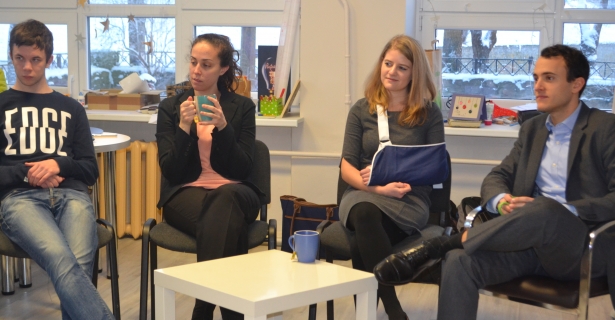Fletcher School students Victoria Barber, Andrew Koch and Kaitlyn Neuberger recently traveled to Estonia, Latvia, Lithuania and Germany to conduct research on the risks of Russian hybrid warfare, focusing on the Baltics. The team’s research was supported by an IGL scholarship with funding from a grant from the Carnegie Corporation of New York.
We are a group of second year Master's candidates from The Fletcher School of Law and Diplomacy at Tufts. As part of the requirements for our degree, we are completing a joint thesis project, focused on how a newly resurgent Russia is challenging the security structure that has dominated the European continent since the fall of the Soviet Union.
Current scholarship provides a great many insights on this issue; however, we felt that first hand research, conducted on the ground in Eastern Europe, would be the best way to truly understand this changing dynamic. With the generous support of the Institute for Global Leadership and The Fletcher School's International Security Studies Program, our team was able to create a trip to the Baltic States--Estonia, Latvia, and Lithuania--and Germany. The goal of our trip is to meet with government and military officials from those countries, diplomats and military officers from the United States, national and local government leaders, journalists, and thought leaders at think tanks and universities.
Our team arrived in Tallinn on the 4th of January and participated in meetings and other events in Tallinn, Narva, and Tartu--the three largest cities in Estonia. Each of these cities has given us a new and valuable perspective on our research project, but Narva was by far the most eye-opening from a cultural and geopolitical perspective.
Narva is the third largest and northeastern most city in Estonia, and only a river and a heavily guarded border crossing separate the city from Russia. Unlike much of the rest of Estonia, Narva is 95% Russian-speaking. We went to Narva to better understand how the minority Russian population is integrated into the Estonian state, and how this population perceives the relationship between Estonia and Russia.
To understand the experience of the Russian population in Estonia, it is important to understand Estonia’s unique history. The idea of an Estonian nation-state is relatively new. A formal Estonian state only came into existence in the 1920s, but this state did not last long. Estonia’s sovereignty was essentially given to the Soviet Union in the German-Soviet Nonaggression Pact in 1939 and after, throughout the Second World War, either the German or Soviet armies occupied the country. After the war, the Soviet Union occupied and then integrated Estonia into the union. Estonia, which had been a relatively homogenous society before the war and the integration, suddenly faced a significant relocation of Russians into their territory. This “Russification” created a legacy that still colors many of the attitudes of Estonians today. When the Soviet Union fell apart, Estonia and the other Baltic States were some of the first to withdraw, creating an unusual situation for the Russian population which had moved into Estonia during the time of union. They were Russian, but their families, jobs, and possessions were all in Estonia. Some decided to move into the new Russian Federation, but most decided to stay in Estonia. The Estonian republic that emerged from the Soviet Union focused completely on disassociating itself with the old Soviet Union and the new Russian Federation. Instead, it developed strong relationships with both the European Union and NATO, eventually joining both organizations. By joining both organizations, Estonia made clear its desire to establish its identity as separate from Russia and to align its political and military interests with the West, rather than Russia. The Russian-speaking minority population was torn over these decisions; while they saw the benefits of being part of the European Union in terms of a higher standard of living compared to their families in Russia, they were still drawn to the Russian Federation because of their heritage. In Estonia, today, the Russian-speaking minority is broken up into three different types: Russian speakers who are Estonian citizens, Russian speakers living in Estonia but who maintain Russian citizenship, and a third group who are essentially legally stateless. This third group are neither citizens of Estonia nor Russia, but can travel, visa-free, between Russia, Estonia, and the EU. This puts them in an unusual legal limbo within their home country of Estonia, but many prefer the designation because of its flexibility.
In Narva we were able to meet with a journalist for the Narva Gazette, the Director of the University of Tartu-Narva College, and the Deputy Mayor of the city. They all had valuable perspectives on understanding how the Russian-speaking minority feels being split between Russia and Estonia and efforts being taken by the Estonian government to better integrate this population after years of isolation. Each of our interviewees provided us with a unique perspective on the Russian minority experience in Estonia.- While we are still in the process of analyzing our findings from this first week of meetings, our trip to Narva was one of the most enlightening days of our trip so far and proves that the best way to get the information that you need is to be on the ground talking to the people who live these situations everyday.
Next we head to Latvia, Lithuania, and Germany. We’ll be back on the blog later in our trip to tell you more about what we learned!
Andrew Koch, Kaitlyn Neuberger, and Victoria Barber

